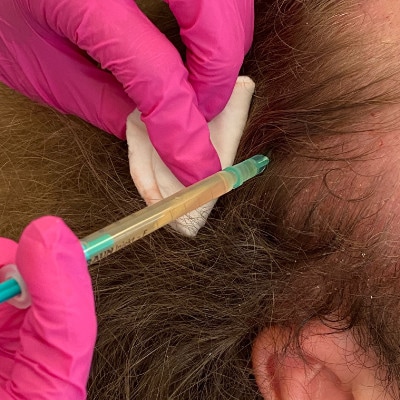PRP for Hair Loss at a Glance
PRP treatment is a new method to stimulate hair growth and halt hair loss.
Autologous Platelet-Rich Plasma (PRP) is injected into the scalp, containing growth factors that revitalize the hair follicles.
In successful cases, hair growth can be improved for several months up to a year.
The PRP treatment typically takes about 60 to 90 minutes per session.
Since PRP is derived from your own blood, side effects are rare. Possible temporary reactions may include mild swelling or redness of the scalp.
For best results, 3–5 sessions are typically required, with intervals of 4 to 6 weeks between each session.
A PRP hair treatment costs approximately €290 per session (indicative price, individual billing according to German Fee Schedule GOÄ).

How Does PRP Therapy for Hair Loss Work?
What is PRP?
PRP therapy is a minimally invasive procedure that utilizes autologous blood plasma to stimulate hair growth and combat hair loss. The plasma contains a high concentration of growth factors that promote cell renewal and tissue regeneration. After processing, the PRP is injected into the scalp to unleash its regenerative properties and stimulate hair growth.
How Does PRP Work?
PRP therapy involves several steps to achieve optimal results. Initially, a small amount of blood is drawn from the patient, similar to a conventional blood test. The blood is then placed in a centrifuge to separate its various components. The obtained plasma, which has a high concentration of growth factors, is used for injection into the scalp. Prior to the injection, the scalp is thoroughly cleansed and numbed to minimize any potential discomfort during the procedure. Subsequently, small injections of PRP are administered to the affected areas of the scalp, stimulating hair growth and halting hair loss.
What are the Benefits of PRP?
PRP therapy offers various advantages for individuals experiencing hair loss. One of the main benefits is that it is a non-surgical procedure. Unlike invasive treatments such as hair transplantation, PRP therapy does not require surgery, making it less burdensome on the body. Furthermore, the use of autologous plasma reduces the risk of allergic reactions or rejection. PRP therapy can be applied to various types of hair loss, including hereditary hair loss, alopecia areata, and telogen effluvium.
Mechanism of Action Unclear
The exact mechanism by which PRP treats hair loss has not been definitively determined. It is believed that the growth factors in PRP positively influence the anagen phase, during which the hair follicles reach their maximum size. Additionally, increased production of certain proteins crucial for the cell cycle is thought to play a vital role.
PRP for Alopecia Areata
While hereditary hair loss is clearly attributed to genetic factors, the causes of alopecia areata (AA), also known as patchy hair loss, are not yet fully understood. Alopecia areata affects both men and women relatively equally, and can even occur in children. Unlike androgenetic alopecia, it is not primarily age-related.
Autoimmune Reaction Likely Cause
One of the suspected causes of alopecia areata is disruptions in the immune system (autoimmune reactions). Due to a malfunction in the immune system, there is an immune response against the hair follicle cells, resulting in inflammation, decreased hair growth, and hair loss. This leads to the formation of round, bald patches on the scalp, giving the condition its name.
Most commonly, scalp hair is impacted, but it can also affect the beard, eyebrows, and body hair. In severe cases, individuals may experience complete loss of body hair (alopecia areata universalis).
Alopecia areata is often associated with other autoimmune diseases, primarily eczema (atopic dermatitis) and vitiligo (depigmentation disorder). This correlation suggests that an immune disorder may also be involved in the development of alopecia areata.
PRP Stimulates Hair Growth and (Maybe) Immune System
Several studies have shown promising results regarding the effectiveness of PRP therapy for alopecia areata. It is believed that PRP stimulates the regeneration and growth of hair follicles, similar to its effects in androgenetic alopecia. Additionally, there is a theory that the growth factors in PRP influence the immune system and reduce the autoimmune reaction against the hair follicles. Both mechanisms contribute to reducing hair loss and promoting hair growth.
How Long Does the Effect of PRP Last?
Duration of Results Varies
The duration of PRP therapy results can vary from person to person and depends on various factors. It is important to note that PRP therapy is not a permanent solution for hair loss, as the hair loss process often continues, and genetic and other factors may come into play. However, PRP therapy can significantly improve hair growth and delay further hair loss.
Typically, patients can observe an improvement in hair growth within a few months after PRP treatment. The hair often becomes denser and healthier. The longevity of the results depends on several factors, including the severity of hair loss, the individual body’s response to the treatment, and the patient’s lifestyle.
Studies Confirm Long-Term Effect of PRP Therapy
Several studies have been conducted to examine the long-term effects of PRP therapy. One study tracked patient outcomes for one year following the treatment. The results showed that most patients maintained improved hair density even after one year. It was found that regular maintenance treatments can help sustain the results over a longer period.
Regular Maintenance Treatments Recommended
The number of required maintenance treatments varies from person to person and can be influenced by different factors. It is advisable to schedule regular follow-up appointments with your treating physician to monitor the condition of your hair and determine the need for further treatments. Your doctor can provide appropriate guidance and establish the best treatment schedule based on your individual needs.
It is also important to note that while PRP therapy can slow down the progression of hair loss, it may not fully restore hair growth in cases of advanced baldness. For patients with advanced hair loss, a combination therapy of hair transplantation and PRP may be necessary to achieve optimal results.
Conclusion: PRP – An Innovative and Gentle Therapy for Hair Loss
PRP therapy offers a promising solution for individuals struggling with hair loss and seeking effective treatment methods. With its minimally invasive nature, minimal side effects, and versatile applications, PRP has established itself as an effective method for stimulating hair growth. From hereditary and alopecia areata to telogen effluvium, PRP therapy can be an effective treatment option.
To make the most of PRP therapy, it is crucial to seek experienced professionals who possess in-depth knowledge and expertise in performing this treatment. Together, you can develop the best approach for your specific needs and embark on a journey towards healthy and full hair.
If you would like further information or would like to discuss your personal situation with me, please feel free to contact me or schedule a consultation appointment.

About the Author:
Dr. med. univ. Eva Maria Strobl is the owner of LIPS and SKIN Aesthetic Medicine practice in Munich. She is a trained specialist in general medicine (MedUni Vienna) and has over 10 years of specialization in non-surgical aesthetic procedures. She is a member of the German Society for Aesthetic Botulinum Therapy e.V. (DGBT), the German Society of Anti-Aging Medicine e.V. (GSAAM) and of Network Global Health. She publishes regularly on her blog and on DocCheck.

